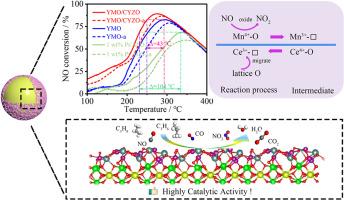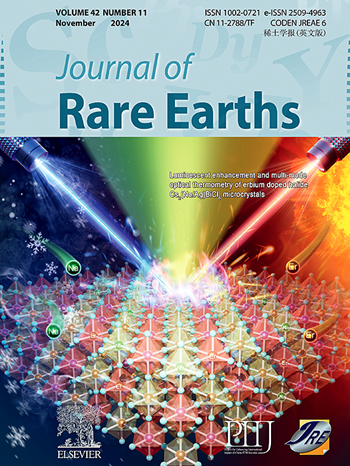构建核壳型稀土-锰-锆复合化合物提高NO氧化催化活性
IF 7.2
1区 化学
Q1 CHEMISTRY, APPLIED
引用次数: 0
摘要
NO催化氧化是柴油氧化催化剂(DOC)的关键性能。本文提出了一种快速沉积的方法,将Mn莫来石相均匀负载在锆基复合材料(YMO/CYZO)表面,该方法在模拟柴油燃烧条件下具有优越的NO氧化催化性能,并且比莫来石相的YMn2O5氧化物具有更好的热稳定性。250℃时,YMO/CYZO-a的NO氧化率接近25.2%,而YMn2O5-a的NO氧化率为13.52%。然后比较了YMO/CYZO、YMO和1 wt% Pt/Al2O3在NO + O2气氛中的催化性能。当温度为274℃,GHSV为50000 h-1时,YMO/CYZO氧化成NO的最大转化率为89.6%,性能优于YMO(293℃时的82.8%)和1wt % Pt/Al2O3(335℃时的68.6%)。无温度程序脱附(NO- tpd)和漫反射红外傅里叶变换光谱(DRIFTS)结果表明,YMO/CYZO具有多个NO吸附位点和高存储容量。密度泛函理论(DFT)计算表明,YMO/CYZO具有较低的氧空位形成能(Ev = 0.93 Ev)和较好的NO吸附能(Eads = - 2.1 Ev)。此外,原位x射线光电子能谱(XPS)表征表明,YMO/CYZO的核壳结构具有传递活性氧的潜力,有助于在反应过程中实现Mn3+到Mn4+,从而增强NO *分子的转化,而NO氧化反应遵循MvK机制。本文章由计算机程序翻译,如有差异,请以英文原文为准。

Constructing a core–shell rare earth-manganese-zirconium composite compound to improve catalytic activity of NO oxidation
NO catalytic oxidation is the key performance of the diesel oxidation catalyst (DOC). We present a facile deposition method for the core–shell rare-earth manganese-zirconium composite oxide that shows the Mn mullite phase uniform loading on the surface of zirconium-based composite (YMO/CYZO), which demonstrates a superior NO oxidation catalytic performance in simulated diesel combustion conditions and better thermal stability than mullite phase YMn2O5 oxide. The NO oxidation at 250 °C over YMO/CYZO-a approaches 25.2% in contrast to 13.52% over YMn2O5-a. Then the catalytic performance of YMO/CYZO, YMO and commercial 1 wt% Pt/Al2O3 in a NO + O2 atmosphere was compared. The maximum conversion rate of YMO/CYZO to NO oxidation is 89.6% at 274 °C with a GHSV of 50000 h–1, and the performance is superior to that of YMO (82.8% at 293 °C) and 1 wt% Pt/Al2O3 (68.6%, 335 °C). The NO-temperature programmed desorption (NO-TPD) and diffused reflectance infrared Fourier transform spectroscopy (DRIFTS) results reveal that YMO/CYZO has multiple NO adsorption sites and high storage capacity. Furthermore, density functional theory (DFT) calculation indicates that YMO/CYZO has lower oxygen vacancy formation energies (Ev = 0.93 eV) and favorable NO adsorption energies (Eads = −2.1 eV). Moreover, in situ X-ray photoelectron spectroscopy (XPS) characterization shows that the core–shell structure of YMO/CYZO has the potential to transmit active oxygen species to help realize Mn3+ to Mn4+ during the reaction process to enhance the conversion of NO∗ molecules, while NO oxidation reactions follow the MvK mechanism.
求助全文
通过发布文献求助,成功后即可免费获取论文全文。
去求助
来源期刊

Journal of Rare Earths
化学-应用化学
CiteScore
8.70
自引率
14.30%
发文量
374
审稿时长
1.7 months
期刊介绍:
The Journal of Rare Earths reports studies on the 17 rare earth elements. It is a unique English-language learned journal that publishes works on various aspects of basic theory and applied science in the field of rare earths (RE). The journal accepts original high-quality original research papers and review articles with inventive content, and complete experimental data. It represents high academic standards and new progress in the RE field. Due to the advantage of abundant RE resources of China, the research on RE develops very actively, and papers on the latest progress in this field emerge every year. It is not only an important resource in which technicians publish and obtain their latest research results on RE, but also an important way of reflecting the updated progress in RE research field.
The Journal of Rare Earths covers all research and application of RE rare earths including spectroscopy, luminescence and phosphors, rare earth catalysis, magnetism and magnetic materials, advanced rare earth materials, RE chemistry & hydrometallurgy, RE metallography & pyrometallurgy, RE new materials, RE solid state physics & solid state chemistry, rare earth applications, RE analysis & test, RE geology & ore dressing, etc.
 求助内容:
求助内容: 应助结果提醒方式:
应助结果提醒方式:


